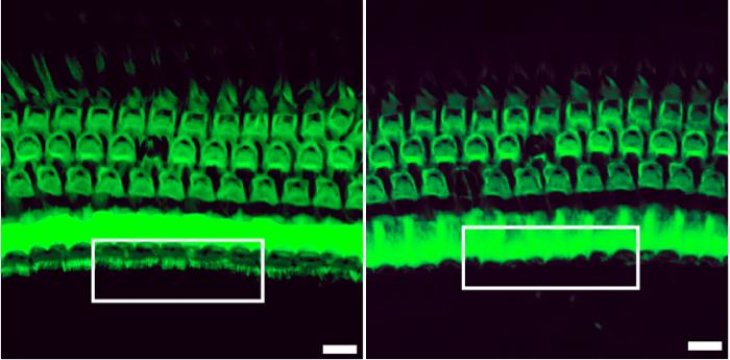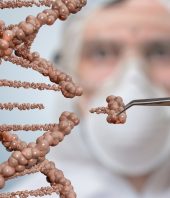Using molecular scissors wrapped in a greasy delivery package, researchers have disrupted a gene variant that leads to deafness in mice.
A single treatment involving injection of a genome editing cocktail prevented progressive hearing loss in young animals that would have otherwise gone deaf, Howard Hughes Medical Institute (HHMI) Investigator David Liu and colleagues report December 20, 2017 in the journal Nature.
The work is among the first to apply a genome editing approach to deafness in animals, Liu says. Because the study was performed in mice, the implications for treating humans are still unclear. But, he says, "We hope that the work will one day inform the development of a cure for certain forms of genetic deafness in people."
Nearly half of all cases of deafness have a genetic root, but treatment options are limited. That's because, until recently, researchers didn't have the technology to directly treat the underlying problem: the genetic mutations that sabotage hearing.
One such mutation is in a gene called Tmc1. A single spelling error in this gene causes the loss of the inner ear's hair cells over time. These delicate bristle-covered cells help detect sound: sound waves bend the bristles, like stalks of wheat in the wind; hair cells then convert that physical information into nerve signals that travel to the brain.
Just one copy of a mutated Tmc1 gene causes progressive hearing loss leading to profound deafness, both in humans and in mice. Liu and colleagues surmised that destroying the mutated copy of the gene, called Beethoven in mice, might preserve some hearing.
So the researchers tapped the genome editing technology known as CRISPR-Cas9. Cas9, an enzyme that acts as molecular scissors, snips both strands of the DNA double helix, which can ultimately disable a gene. But directing Cas9 to only the bad copy of Tmc1 -- and not the good one -- is tricky, because the two copies differ by just one DNA letter. Scientists use an RNA guide to lead Cas9 to its target, but after a while, the enzyme can begin cutting other DNA that looks similar.
Liu's team employed a technique that they had reported in 2015. They packaged Cas9 and the guide RNA into a greasy bundle that slips inside cells -- and doesn't stick around. That let Cas9 hit the bad gene copy, and fade away before it could harm the good one, says Liu, the Richard Merkin Professor and Vice-Chair of the Faculty at the Broad Institute, and Professor of Chemistry and Chemical Biology at Harvard University.
Liu's team began this work years before his team invented a more recent genome editing tool known as base editors. But, in principle, he says, the precision editing capabilities of base editors could also directly correct, rather than disrupt, mutations linked to hearing loss disorders.
Study coauthor Zheng-Yi Chen of Harvard Medical School and coworkers injected the CRISPR-based tool into the inner ears of infant mice with the hearing loss mutation. After eight weeks, hair cells in treated ears resembled those in healthy animals -- densely packed and tufted with hairlike bundles. The hair cells of untreated mice, in contrast, looked damaged and sparse.
Then the researchers measured inner ear function by placing electrodes on mice's heads and monitoring activity of brain regions involved in hearing. Researchers needed more sound to spark brain activity in untreated mice compared with treated mice, the team found. On average, after four weeks, treated ears could hear sounds about 15 decibels lower than untreated ears. "That's roughly the difference between a quiet conversation and a garbage disposal," Liu says.
In humans, such a change could make a major difference in hearing-loss patients' quality of life, he says.
Scientists still have a long way to go before trying this approach in humans. But if applicable, the treatment could be best during childhood, Liu says. That's because hair cell loss in the inner ear is progressive and irreversible. "The conventional thinking in the field is that once you've lost your hair cells, it's difficult to get them back."
Howard Hughes Medical Institute. (2017, December 20). CRISPR treatment prevents hearing loss in mice. ScienceDaily. Retrieved December 22, 2017 from www.sciencedaily.com/releases/2017/12/171220131701.htm






